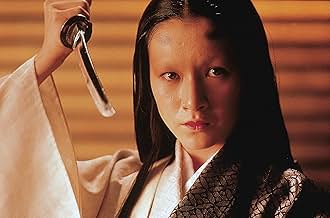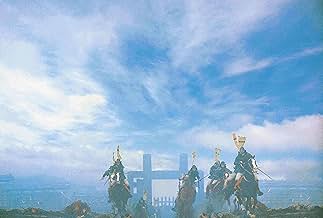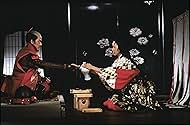Im mittelalterlichen Japan setzt sich ein alter Kriegsherr zur Ruhe und übergibt sein Reich seinen drei Söhnen. Er hat jedoch vollkommen unterschätzt, wie sehr die neue Macht in ihren Händen... Alles lesenIm mittelalterlichen Japan setzt sich ein alter Kriegsherr zur Ruhe und übergibt sein Reich seinen drei Söhnen. Er hat jedoch vollkommen unterschätzt, wie sehr die neue Macht in ihren Händen sie korrumpieren würde, sodass sie aufeinander losgehen ...auch auf ihn.Im mittelalterlichen Japan setzt sich ein alter Kriegsherr zur Ruhe und übergibt sein Reich seinen drei Söhnen. Er hat jedoch vollkommen unterschätzt, wie sehr die neue Macht in ihren Händen sie korrumpieren würde, sodass sie aufeinander losgehen ...auch auf ihn.
- 1 Oscar gewonnen
- 30 Gewinne & 23 Nominierungen insgesamt
Mansai Nomura
- Tsurumaru
- (as Takeshi Nomura)
Ausgewählte Rezension
What a wonderfully varied medium film can be! Here we have a film that is both truly great and in a different way a clumsy mistake.
By now you know that this was made by a master filmmaker at the end of his life -- in preparation for ten years and Asia's most expensive film. He intended it to be his last, his masterpiece.
The Good: This work of art is a sequence of masterfully composed images. The camera remains stationary or virtually so, and each scene is richly rewarding in all the visual dimensions, including motion. The costumes are the most cinematic I have seen. There is a use of grasshopper sounds that is the best example I know of amplifying an image by sound. The frame of the picture is the landscape -- little takes place indoors, and that action always refers to some larger, exterior motion. In my experience, this is the best complement of Wells' Othello, the most masterful use of interior space I know.
I give it a ten because it is a masterpiece in this area of cinematic communication, one that seems exceptionally underaddressed.
The Bad: The Master attempted too much in trying to match his cinematic virtuosity by swallowing Shakespeare's Lear to produce an equally rich story. In this he fails -- so many problems here. First, Shakespeare wrote plays for a barren stage where the images grow from the mind, supported by super-rich language and interwoven visual metaphor. The scene grows from our understanding of the character and what that character says. Kurosawa tries it backwards here by placing characters is a vast scheme that came from his own mind, off-screen as it were, and it doesn't quite work.
As it happens, Ran's emphasis is on grand motion. Little time is spent on character development, except with the scheming wife of the first son (a story element that has little Shakespearean counterpart). Lear is a play about demons and leaves the question open as to how many are from opportunistic devilment and which are internally generated. All this is discarded here, as well as the Gloucester counterplot. Among the great losses from the source are the continuous examinations of what sight means and what it can conceive. How fertile that would have been as dramatic scaffolding for Kurosawa's vision.
There's a problem with language as well. Not knowing Japanese, I cannot judge how rich or intricate in metaphor is the film's dialogue. But the sound and dramatic utility of the speech is about as far from Shakespeare as you can get. Shakespeare uses his actors' speech to simultaneously move the dramatic action and to serve as a surrogate for the viewer's mind. Both the story and your own ruminations on the story are contained therein. This depends on a continuous, predictable assumed rythmic base which is articulated by a rich consonant based, cheating rubato. Japanese consists of staccato vowels that I suspect are overly dramatized in the short blasts we get from these characters. Could hardly be more unShakespearean. I assume there is a Noh legacy being mined here instead, which is not available to this western viewer.
A side note: after seeing these battle scenes you'll never appreciate Speilberg's blatant ripoff in the first part of Sgt Ryan.
By now you know that this was made by a master filmmaker at the end of his life -- in preparation for ten years and Asia's most expensive film. He intended it to be his last, his masterpiece.
The Good: This work of art is a sequence of masterfully composed images. The camera remains stationary or virtually so, and each scene is richly rewarding in all the visual dimensions, including motion. The costumes are the most cinematic I have seen. There is a use of grasshopper sounds that is the best example I know of amplifying an image by sound. The frame of the picture is the landscape -- little takes place indoors, and that action always refers to some larger, exterior motion. In my experience, this is the best complement of Wells' Othello, the most masterful use of interior space I know.
I give it a ten because it is a masterpiece in this area of cinematic communication, one that seems exceptionally underaddressed.
The Bad: The Master attempted too much in trying to match his cinematic virtuosity by swallowing Shakespeare's Lear to produce an equally rich story. In this he fails -- so many problems here. First, Shakespeare wrote plays for a barren stage where the images grow from the mind, supported by super-rich language and interwoven visual metaphor. The scene grows from our understanding of the character and what that character says. Kurosawa tries it backwards here by placing characters is a vast scheme that came from his own mind, off-screen as it were, and it doesn't quite work.
As it happens, Ran's emphasis is on grand motion. Little time is spent on character development, except with the scheming wife of the first son (a story element that has little Shakespearean counterpart). Lear is a play about demons and leaves the question open as to how many are from opportunistic devilment and which are internally generated. All this is discarded here, as well as the Gloucester counterplot. Among the great losses from the source are the continuous examinations of what sight means and what it can conceive. How fertile that would have been as dramatic scaffolding for Kurosawa's vision.
There's a problem with language as well. Not knowing Japanese, I cannot judge how rich or intricate in metaphor is the film's dialogue. But the sound and dramatic utility of the speech is about as far from Shakespeare as you can get. Shakespeare uses his actors' speech to simultaneously move the dramatic action and to serve as a surrogate for the viewer's mind. Both the story and your own ruminations on the story are contained therein. This depends on a continuous, predictable assumed rythmic base which is articulated by a rich consonant based, cheating rubato. Japanese consists of staccato vowels that I suspect are overly dramatized in the short blasts we get from these characters. Could hardly be more unShakespearean. I assume there is a Noh legacy being mined here instead, which is not available to this western viewer.
A side note: after seeing these battle scenes you'll never appreciate Speilberg's blatant ripoff in the first part of Sgt Ryan.
Handlung
WUSSTEST DU SCHON:
- WissenswertesAkira Kurosawa's wife of 39 years, Yôko Yaguchi, died during the production of this film. Kurosawa halted filming for just one day to mourn before resuming work on the picture.
- PatzerDuring the battle at the third castle, there is a sequence where Hidetora emerges from the castle at the top of a flight of stairs and confronts enemy soldiers ascending the stairs. When he retreats, his bodyguards suddenly appear and retreat with him, even though they were not present moments earlier.
- VerbindungenFeatured in A.K. (1985)
Top-Auswahl
Melde dich zum Bewerten an und greife auf die Watchlist für personalisierte Empfehlungen zu.
Details
Box Office
- Budget
- 11.500.000 $ (geschätzt)
- Bruttoertrag in den USA und Kanada
- 4.135.750 $
- Eröffnungswochenende in den USA und in Kanada
- 3.567 $
- 2. Juli 2000
- Weltweiter Bruttoertrag
- 4.176.838 $
- Laufzeit2 Stunden 40 Minuten
- Farbe
- Seitenverhältnis
- 1.85 : 1
Zu dieser Seite beitragen
Bearbeitung vorschlagen oder fehlenden Inhalt hinzufügen



































